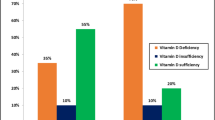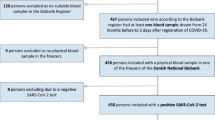Abstract
Objective
Vitamin D (VD) deficiency was reported to contribute to the progression of Crohn’s disease (CD) and affect the prognosis of CD patients. This study investigated the role of serum VD, body mass index (BMI), and tumor necrosis factor alpha (TNF-α) in the diagnosis of Crohn’s disease.
Methods
CD patients (n=76) and healthy subjects (n=76) were enrolled between May 2019 and December 2020. The serum 25-hydroxyvitamin D [25(OH)D] levels, BMI, and TNF-α levels, together with other biochemical parameters, were assessed before treatment. The diagnostic efficacy of the single and joint detection of serum 25(OH)D, BMI, and TNF-α was determined using receiver operating characteristic (ROC) curves.
Results
The levels of 25(OH) D, BMI, and nutritional indicators, including hemoglobin, total protein, albumin, and high-density lipoprotein cholesterol, were much lower, and the TNF-α levels were much higher in the CD patients than in the healthy subjects (P<0.05 for all). The areas under the ROC curve for the single detection of 25(OH)D, BMI, and TNF-α were 0.887, 0.896, and 0.838, respectively, with the optimal cutoff values being 20.64 ng/mL, 19.77 kg/m2, and 6.85 fmol/mL, respectively. The diagnostic efficacy of the joint detection of 25(OH)D, BMI, and TNF-α was the highest, with an area under the ROC curve of 0.988 (95%CI: 0.968–1.000).
Conclusion
The joint detection of 25(OH)D, TNF-α, and BMI showed high sensitivity, specificity, and accuracy in CD diagnosis; thus, it would be effective for the diagnosis of CD in clinical practice.
Similar content being viewed by others
References
Torres J, Mehandru S, Colombel JF, et al. Crohn’s disease. Lancet 2017,389(10080):1741–1755
Baumgart DC, Sandborn WJ. Crohn’s disease, Lancet, 2012, 80(9853):1590–1605
Ng SC, Tang W, Ching JY, et al. Incidence and phenotype of inflammatory bowel disease based on results from the Asia-pacific Crohn’s and colitis epidemiology study. Gastroenterology 2013,145(1):158–165
Molodecky NA, Soon IS, Rabi DM, et al. Increasing incidence and prevalence of the inflammatory bowel diseases with time, based on systematic review. Gastroenterology 2012,142(1):46–54
Zhang YZ, Li YY. Inflammatory bowel disease: pathogenesis. World J Gastroenterol 2014,20(1):91–99
Lu C, Merrill C, Medellin A, et al. Bowel Ultrasound State of the Art: Grayscale and Doppler Ultrasound, Contrast Enhancement, and Elastography in Crohn Disease. J Ultrasound Med 2019,38(2):271–288
Taylor SA, Mallett S, Bhatnagar G, et al. Magnetic resonance enterography compared with ultrasonography in newly diagnosed and relapsing Crohn’s disease patients: the METRIC diagnostic accuracy study. Health Technol Assess 2019,23(42):1–162
Rosen CJ. Clinical practice. Vitamin D insufficiency. N Engl J Med 2011,364(3):248–254
Sherman MH, Yu RT, Engle DD, et al. Vitamin D receptor-mediated stromal reprogramming suppresses pancreatitis and enhances pancreatic cancer therapy. Cell 2014,159(1):80–93
Johnson LA, Sauder KL, Rodansky ES, et al. CARD-024, a vitamin D analog, attenuates the pro-fibrotic response to substrate stiffness in colonic myofibroblasts. Exp Mol Pathol 2012,93(1):91–98
Abramovitch S, Dahan-Bachar L, Sharvit E, et al. Vitamin D inhibits proliferation and profibrotic marker expression in hepatic stellate cells and decreases thioacetamide-induced liver fibrosis in rats. Gut 2011,60(12):1728–1737
Frigstad SO, Høivik M, Jahnsen J, et al. Vitamin D deficiency in inflammatory bowel disease: prevalence and predictors in a Norwegian outpatient population. Scand J Gastroenterol 2017,52(1):100–106
Kabbani TA, Koutroubakis IE, Schoen RE, et al. Association of Vitamin D Level With Clinical Status in Inflammatory Bowel Disease: A 5-Year Longitudinal Study. Am J Gastroenterol 2016,111(5):712–719
de Bruyn JR, van Heeckeren R, Ponsioen CY, et al. Vitamin D deficiency in Crohn’s disease and healthy controls: a prospective case-control study in the Netherlands. J Crohns Colitis 2014,8(10):1267–1273
Jørgensen SP, Hvas CL, Agnholt J, et al. Active Crohn’s disease is associated with low vitamin D levels. J Crohns Colitis 2013,7(10):e407–e413
Nielsen OH, Rejnmark L, Moss AC. Role of Vitamin D in the Natural History of Inflammatory Bowel Disease. J Crohns Colitis 2018,12(6):742–752
Valvano M, Magistroni M, Mancusi A, et al. The Usefulness of Serum Vitamin D Levels in the Assessment of IBD Activity and Response to Biologics. Nutrients 2021,13(2):323
Papadakis KA, Targan SR. Role of cytokines in the pathogenesis of inflammatory bowel disease. Annu Rev Med, 2000,51:289–298
Hering NA, Fromm M, Schulzke JD. Determinants of colonic barrier function in inflammatory bowel disease and potential therapeutics. J Physiol 2012,590(5):1035–1044
John LJ, Fromm M, Schulzke JD. Epithelial barriers in intestinal inflammation. Antioxid Redox Signal 2011,15(5):1255–1270
de Souza HS, Fiocchi C. Immunopathogenesis of IBD: current state of the art. Nat Rev Gastroenterol Hepatol 2016,13(1):13–27
Sonnenberg A, Jacobsen SJ, Wasserman IH. Periodicity of hospital admissions for inflammatory bowel disease. Am J Gastroenterol 1994,89(6):847–851
Sandall AM, Wall CL, Lomer MCE. Nutrition Assessment in Crohn’s Disease using Anthropometric, Biochemical, and Dietary Indexes: A Narrative Review. J Acad Nutr Diet 2020,120(4):624–640
Donnellan CF, Yann LH, Lal S. Nutritional management of Crohn’s disease. Therap Adv Gastroenterol 2013,6(3):231–242
Lomer MC, Gourgey R, Whelan K. Current practice in relation to nutritional assessment and dietary management of enteral nutrition in adults with Crohn’s disease. J Hum Nutr Diet, 2014,27(Suppl 2):28–35
Liu JB, Gao X, Zhang FB, et al. The risk factor for low bone mineral density in patients with inflammatory bowel disease. Zhonghua Nei Ke Za Zhi (Chinese) 2009,48(10):833–836
Tang RH, Chao K, Zhang SH, et al. The prevalence and characteristics of anemia in Crohn’s disease in the Chinese. Zhonghua Nei Ke Za Zhi (Chinese) 2013,52(5):370–374
Yan T, Li L, Wu Q, et al. Analysis of body composition in patients with Crohn’s disease. Zhonghua Wei Chang Wai Ke Za Zhi (Chinese) 2014,17(10):981–984
Khan SS, Patil SS. Bone density in pediatric Crohn’s disease: A cross-sectional observation from South India. Indian J Gastroenterol 2017,36(3):184–188
Patsalos O, Dalton B, Leppanen J, et al. Impact of TNF-α Inhibitors on Body Weight and BMI: A Systematic Review and Meta-Analysis. Front Pharmacol, 2020, 11:481
Maaser C, Sturm A, Vavricka SR, et al. ECCO-ESGAR Guideline for Diagnostic Assessment in IBD Part 1: Initial diagnosis, monitoring of known IBD, detection of complications. J Crohns Colitis 2019,13(2):144–164
Best WR, Becktel JM, Singleton JW, et al. Development of a Crohn’s disease activity index. National Cooperative Crohn’s Disease Study. Gastroenterology 1976,70(3):439–444
World Health Organization. Obesity: Preventing and managing the global epidemic: Report of a WHO consultation. World Health Organ Tech Rep Ser, 2000,894:1–253
Holick MF, Binkley NC, Bischoff-Ferrari HA, et al. Evaluation, treatment, and prevention of vitamin D deficiency: an Endocrine Society clinical practice guideline. J Clin Endocrinol Metab 2011,96(7):1911–1930
Ananthakrishnan AN, Khalili H, Higuchi LM, et al. Higher predicted vitamin D status is associated with reduced risk of Crohn’s disease. Gastroenterology 2012,142(3):482–489
Burisch J, Pedersen N, Cukovic-Cavka S, et al. Environmental factors in a population-based inception cohort of inflammatory bowel disease patients in Europe—an ECCO-EpiCom study. J Crohns Colitis 2014,8(7):607–616
Yang Y, Cui X, Li J, et al. Clinical evaluation of vitamin D status and its relationship with disease activity and changes of intestinal immune function in patients with Crohn’s disease in the Chinese population. Scand J Gastroenterol 2021,56(1):20–29
Lu ZL, Wang TR, Qiao YQ, et al. Handgrip Strength Index Predicts Nutritional Status as a Complement to Body Mass Index in Crohn’s Disease. J Crohns Colitis 2016,10(12):1395–1400
Calvert CR, Lal S. Approaches to intestinal failure in Crohn’s disease. Proc Nutr Soc 2011,70(3):336–341
Geerling BJ, Badart-Smook A, Stockbrügger RW, et al. Comprehensive nutritional status in recently diagnosed patients with inflammatory bowel disease compared with population controls. Eur J Clin Nutr 2000,54(6):514–521
Cioffi I, Marra M, Imperatore N, et al. Assessment of bioelectrical phase angle as a predictor of nutritional status in patients with Crohn’s disease: A cross sectional study. Clin Nutr 2020,39(5):1564–1571
de Castro MM, Corona LP, Pascoal LB, et al. Impaired nutritional status in outpatients in remission or with active Crohn’s disease—classified by objective endoscopic and imaging assessments. Clin Nutr ESPEN, 2019,33:60–65
Pallav K, Riche D, May WL, et al. Predictors of vitamin D deficiency in inflammatory bowel disease and health: A Mississippi perspective. World J Gastroenterol 2017,23(4):638–645
Prieto JMI, Andrade AR, Magro DO, et al. Nutritional Global Status and Its Impact in Crohn’s Disease. J Can Assoc Gastroenterol 2021,4(6):290–29
Bendix-Struve M, Bartels LE, Agnholt J, et al. Vitamin D3 treatment of Crohn’s disease patients increases stimulated T cell IL-6 production and proliferation. Aliment Pharmacol Ther 2010,32(11–12):1364–1372
Liu N, Nguyen L, Chun RF, et al. Altered endocrine and autocrine metabolism of vitamin D in a mouse model of gastrointestinal inflammation. Endocrinology 2008,149(10):4799–4808
Canaff L, Hendy GN. Calcium-sensing receptor gene transcription is up-regulated by the proinflammatory cytokine, interleukin-1beta. Role of the NF-kappaB pathway and kappaB elements. J Biol Chem 2005,280(14):14177–14188
Canaff L, Zhou X, Hendy GN. The proinflammatory cytokine, interleukin-6, up-regulates calcium-sensing receptor gene transcription via Stat1/3 and Sp1/3. J Biol Chem 2008,283(20):13586–13600
Joseph AJ, George B, Pulimood AB, et al. 25 (OH) vitamin D level in Crohn’s disease: association with sun exposure & disease activity. Indian J Med Res 2009,130(2):133–137
Ulitsky A, Ananthakrishnan AN, Naik A, et al. Vitamin D deficiency in patients with inflammatory bowel disease: association with disease activity and quality of life. JPEN J Parenter Enteral Nutr 2011,35(3):308–316
Raftery T, Merrick M, Healy M, et al. Vitamin D Status Is Associated with Intestinal Inflammation as Measured by Fecal Calprotectin in Crohn’s Disease in Clinical Remission. Dig Dis Sci 2015,60(8):2427–2435
Jørgensen SP, Agnholt J, Glerup H, et al. Clinical trial: vitamin D3 treatment in Crohn’s disease — a randomized double-blind placebo-controlled study. Aliment Pharmacol Ther 2010,32(3):377–383
Mechie NC, Mavropoulou E, Ellenrieder V, et al. Distinct Association of Serum Vitamin D Concentration with Disease Activity and Trough Levels of Infliximab and Adalimumab during Inflammatory Bowel Disease Treatment. Digestion 2020,101(6):761–770
Hausmann J, Kubesch A, Amiri M, et al. Vitamin D Deficiency is Associated with Increased Disease Activity in Patients with Inflammatory Bowel Disease. J Clin Med 2019,8(9):1319
Wahl DA, Cooper C, Ebeling PR, et al. A global representation of vitamin D status in healthy populations. Arch Osteoporos, 2012,7:155–172
Hilger J, Friedel A, Herr R, et al. A systematic review of vitamin D status in populations worldwide. Br J Nutr 2014,111(1):23–45
Stenczel ND, Purcarea MR, Tribus LC, et al. The role of the intestinal ultrasound in Crohn’s disease diagnosis and monitoring. J Med Life 2021,14(3):310–315
Lin S, Wang Y, Li L, et al. A New Model Based on 25-Hydroxyvitamin D3 for Predicting Active Crohn’s Disease in Chinese Patients. Mediators Inflamm, 2018,2018:3275025
Ng WL, Collins PF, Hickling DF, et al. Evaluating the concurrent validity of body mass index (BMI) in the identification of malnutrition in older hospital inpatients. Clin Nutr 2019,38(5):2417–2422
Snijder MB, van Dam RM, Visser M, et al. Adiposity in relation to vitamin D status and parathyroid hormone levels: a population-based study in older men and women. J Clin Endocrinol Metab 2005,90(7):4119–4123
Wortsman J, Matsuoka LY, Chen TC, et al. Decreased bioavailability of vitamin D in obesity. Am J Clin Nutr 2000,72(3):690–693
Lagunova Z, Porojnicu AC, Lindberg F, et al. The dependency of vitamin D status on body mass index, gender, age and season. Anticancer Res, 2009,29(9): 3713–3720
Raftery T, O’Sullivan M. Optimal vitamin D levels in Crohn’s disease: a review. Proc Nutr Soc 2015,74(1):56–66
Elizondo-Montemayor L, Castillo EC, Rodríguez-López C, et al. Seasonal Variation in Vitamin D in Association with Age, Inflammatory Cytokines, Anthropometric Parameters, and Lifestyle Factors in Older Adults. Mediators Inflamm, 2017,2017:5719461
Acknowledgments
The authors thank our study volunteers, the hospital staff, and the laboratory staff for their assistance in performing the studies.
Author information
Authors and Affiliations
Corresponding authors
Additional information
Conflict of Interest Statement
The authors declare that they have no conflicts of interest.
This research was funded by Guangzhou Science and Technology Plan Projects (No. 202002020066), the Young Scientists to the NSFC Application of Guangdong Provincial People’s Hospital (No. 8210120306) and the Open Foundation of the State Key Laboratory of Bioactive Seaweed Substance (No. SKL-BMSG2022-03).
Rights and permissions
About this article
Cite this article
Zheng, Y., Li, Jh., Liao, Sy. et al. Joint Detection of Serum Vitamin D, Body Mass Index, and Tumor Necrosis Factor Alpha for the Diagnosis of Crohn’s Disease. CURR MED SCI 43, 496–504 (2023). https://doi.org/10.1007/s11596-023-2741-6
Received:
Accepted:
Published:
Issue Date:
DOI: https://doi.org/10.1007/s11596-023-2741-6




